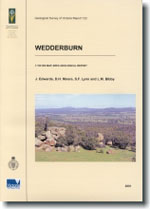GSV Report 122 - Wedderburn 1:100 000 map area geological report
 |
| |||||||||||||||||||||||||||||
Product description:Download The downloadable version of this report is supplied in PDF format and is a large file (13.1MB). Abstract This report describes the geology of the area covered by the Wedderburn 1:100 000 mapsheet, 7625. It contains a summary of previous work and gives a comprehensive account of the physiography, geological history, landscape evolution and structural and economic geology, supported by numerous illustrations. The geological and geophysical characteristics of Palaeozoic and Cainozoic rock units are described, and depositional models are suggested for each. A comprehensive list of references is included. Particular emphasis is placed on the problems associated with the subdivision of the Palaeozoic metasedimentary rocks. During the Late Cambrian–Ordovician an enormous submarine fan system developed along the eastern margin of Gondwana, and a thick sequence of deep marine quartz-rich turbidites was deposited. Previously referred to as Castlemaine Group, part of the sequence is identified as belonging to the older St Arnaud Group. Geophysical data are used to extend the surface Palaeozoic geology beneath the younger sedimentary rocks of the Murray Basin. The Cambrian–Ordovician sequence was folded, faulted and cleaved during the Late Ordovician–Early Silurian. The positions of major faults that were generated at that time, including the Avoca Fault, have been determined with the aid of the geophysical data. Following deformation, granites intruded and metamorphosed the Palaeozoic sedimentary rocks. The geophysical data shows these, including several subsurface intrusions not recognised before. The post-Palaeozoic history is one of successive periods of uplift and erosion related to the tectonic effects of the breakup of the Gondwana landmass, and the development of a sea floor spreading centre between Australia and Antarctica. The formation of the Victorian Highlands and the development and subsequent infilling of the Murray Basin are discussed in relation to the regional tectonics and global eustatic and climatic oscillations. The Murray Basin is currently of interest for heavy mineral sand exploration, and the search for gold continues in the Wedderburn goldfield. Bibliographic reference Edwards, J., Moore, D.H., Bibby, L.M. and Lynn, S.F., 2001. Wedderburn 1:100 000 map area geological report. Geological Survey of Victoria Report 122. Related products:
| ||||||||||||||||||||||||||||||



